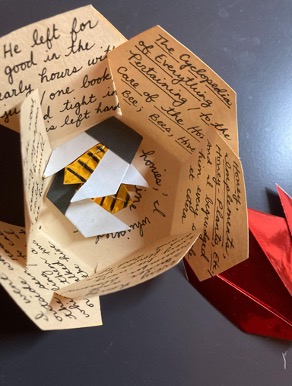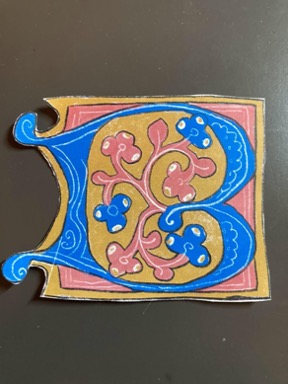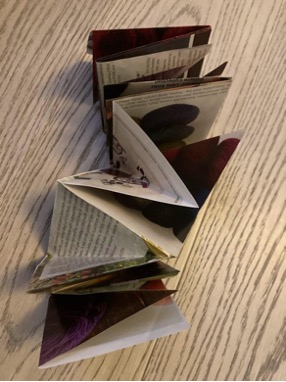Since 2021, in my “Book History in Practice” class at the University of Toronto, I have given an assignment I call “material experiments.” The most basic articulation of the assignment (included below in full) is that students are asked to choose a material feature of books, manuscripts, or printed artifacts, and conduct an at-home experiment of their choice in making something using that material practice. The scope is deliberately broad to allow for a range of historical traditions of textuality and materiality to enter into the conversation (and also to welcome students’ own experiences of contemporary craft cultures and practices to be part of their explorations). It was also initially broad to allow for pandemic lockdown conditions, and for the supplies and materials that students might have available to them in their homes. I should also contextualize this whole reflection with the information that this is a graduate seminar, usually with about 15 students. A luxuriously small class, in other words, lest you think the amount of labour I’m proposing below is (even more) over the top.
In Winter 2021, when I first tried this assignment as an alternative to other academic tasks that had been designed around special collections library access, I was too frazzled trying to make book history real and alive using a document camera at my kitchen counter to take part in the fun. I had prepared basic bookbinding kits for the students and sent them out by mail to try to preserve some of the tactility of our usual in-person teaching practices. I loved what the students brought to this assignment in that first year and was astonished by the results – cuneiform tablets made from polymer clay; ink made from buckthorn berries; illuminated manuscript fragments; books made from recycled flyers and sewn using the unraveled netting from a bag of lemons as thread. These offerings felt especially exciting since we were all in our own ways, in our own homes, having such an odd and lonely time just then.
So, I loved what everyone did with the assignment right from the start. But I didn’t feel like my feedback in that first year, words without material substance or form, really answered their projects. So often with grading we employ the “compliment sandwich” and call it a day. But I found myself wondering how I ought to respond to something so raw and new? How should you grade an assignment that is asking students to try a brand new, and also centuries-old, practice for the first time? It seemed to me that the way this was working was that the students were taking all the risks, and I was sitting here in my usual place as the professor with my usual approach to feedback. I needed a new way of handling my responses to this kind of work: a method that would allow this to become more of a real conversation.
At first, I thought I would just make my own “material experiments” project and take part in the workshop/show-and-tell day as a participant. I’d make an artist’s book with some poems, or I’d finally get back to the Bibliography Room with its letterpress printing equipment regularly enough to set a broadside of some thoughtful book history quote or other and print each student a copy. Then it occurred to me that I might have something different to say to each of the students in the language we were primarily using in this assignment: the language of materials.
So, I looked carefully at each of the students’ projects from the 2022 Winter class and thought about them for a while. One student’s small artist’s book made me think about bees, hexagons, the particular shape of a honeycomb, and the new things I’d learned from her about the role of bees in Early Modern colonization. Another made me think about how we read and re-read academic texts, and how we might be able to read theory and criticism using scissors and a glue stick. Two students brought me back to lino, one of the first types of printmaking I ever tried, but one I hadn’t picked back up in the two decades since I tried it in high school. Another student’s book raised the possibilities of the book and/as the body, with the distinct qualities of paper, sewing, gold leaf, and calligraphy all contributing to the whole. Yet another’s rebinding of an old broken book evoked all the patience and care inherent in acts of restoration and repair. Of course, there were many more, and each project was so different that it was clear I needed to figure out precise and specific responses for each.
When I gathered supplies and started to make my small experiments, I felt vulnerable and humbled. This of course is partly because sometimes things went a bit wrong. The Suminogashi marbling didn’t turn out as beautifully as I’d hoped, and then my three-year-old took most of the sheets we made to preschool and gave them away. The paper I chose at first for the linocut prints wasn’t quite right. I messed up some folds, used the wrong kind of glue, measured things slightly inaccurately. With nearly every project I had anxieties about my ability to accomplish these tasks with any kind of skill. I have tremendous respect for professional conservators, book artists, and printers who do this for real, and I know that despite my interest in and enthusiasm for these things, and my own research interest in letterpress printing, I’m not one of them. So then, there’s always the risk of this seeming somehow childish or problematically amateurish. It is, I think, important that I went through these struggles and doubts, because I know more now about what it feels like to do this assignment. It is fun and new, freeing and frustrating, all pretty much in equal measure.
But here’s what I think happened as I was doing this work of thinking about how to respond to student pieces with something of my own. This, like all of the students’ own efforts, took time. It’s rare to find an activity in the book arts that can be rushed. It’s often slow work, it’s precise, and it’s exacting. I also thought about each of the students as I was reading the reflections and thinking through their projects. I don’t know why, but folding little bees out of paper, or cutting out bits of newspaper to fold into a zine made me so aware of the person behind their material projects: their curiosities, their interests, and their fascinations. This for me was an exercise in learning the value of time, care, and connection, not only to each other, but also to the techniques, methods, and experiences of the past. Each student learned both practically and conceptually about materials and the value of doing things with their hands. Beyond that, they genuinely found connections to their broader research interests in book history.
I also know I learned a lot in making these projects about both the past world of the book and the present world of strangeness and social disconnection. I first became interested in book history through Virginia Woolf’s Hogarth Press. I loved those early hand-printed books she made partly because they seemed just like these material experimental projects. She didn’t know what she was doing. She was more or less untrained. She was just trying to make some beautiful(ish) form to house her words and to free her from the unhelpful external constraints of editorial expectation and trade those for the new constraints she encountered within and through the materials of book making. This amateur exercise gave her something different than her professional writing life did. In a recent essay on her own first pedagogical experiences with letterpress, American memoirist Beth Kephart comments on these early Hogarth Press publications as pedagogical exercises:
Uniformity is not the concern. Perfection is not the ambition, and certainly not the result, though the making of each book provides a lesson in the making of the next—how to prepare the woodcut illustrations, how to set the margins, how much ink is too much ink, how to become more exacting in the necessaries of proofreading, how to keep each printed page the same dimension.
Beth Kephart on Virginia Woolf, “Moving the Type” The Curator, May 2021
As my students and I learned ‘how much ink is too much ink,’ and other material lessons, we were also learning what it meant to re-inhabit some of the material postures and practices of the past, and at the same time to give something thoughtful to each other in the present.
Assignment: Material documentation & 1000-word reflection paper
“Books, pamphlets, and magazines transmit knowledge by physical form. The message is conveyed by the medium. Books share some of the characteristics of other material goods. Tactility, design, and ornamentation convey meaning even before a book is read.” (James Raven, “Introduction” The Oxford Illustrated History of the Book).
This exploratory assignment will provide an opportunity for experiential learning about material textuality. You will choose a material feature of books, manuscripts, or printed artifacts, and conduct an at-home experiment of your choice. Perhaps you will try Suminogashi marbling, making blackberry or iron gall ink, making paper, carving a quill, creating linocut print, hand-lettering using historical calligraphy samples, sewing a pamphlet, making a zine, trying some paper engineering or pop-up features, binding a book, undertaking a bibliographic exercise (like a title page transcription), designing a dust jacket, or building a solander box. There are many options here and you should choose something that you’re enthusiastic about! We will be covering some of the possibilities in class through the bookbinding workshop and the ink and paper making demonstrations. There will be a section of our online materials devoted to tutorials, videos, and instructional manuals for the various different types of projects you might undertake, but you are encouraged to do your own additional research on your chosen material practice as well. You will be very welcome to use the tools provided in your class toolkit for this project as well as common supplies you can find in your home or at the grocery store.
You will submit two main components for this assignment: documentation of your material experiments and a reflection paper.
The first component will be the material documentation showing what you made and how you made it. This means that you should, as much as possible, record every step you take of your process, describe how you completed your work, and provide images, videos, and other visual communication tools. To share and keep track of your notes and records, you might find free and easy-to-use digital tools like Padlet, Goodnotes, Trello, Conceptboard, Powerpoint, or WordPress helpful. The documentation should be able to be submitted digitally in some form (a link, document or photo album, or even a scanned paper notebook).
Alongside your documentation of your material experiments, you will also submit a brief reflection paper outlining your process and reflecting on particular challenges you faced, solutions you devised, unexpected things you learned, and the insight that you gained from making these objects into their presence in books or textual artifacts you encounter.
You should submit a properly formatted bibliography including all the sources you consulted. This is one assignment for which non-scholarly sources such as how-to guides, artists’, conservators’ and practitioners’ notes, and instructional manuals are very welcome as supplements to your book history foundations if they help you.
Please be reassured that these are understood to be first forays into material skills that can take years of apprenticeship to learn, and as such your grade will be based on the quality of your analytical reflections, your research, and your documentation of your process. If the final product doesn’t quite look professional or if you run into execution troubles, that will in no way negatively impact your grade if your research and reflections are strong.




